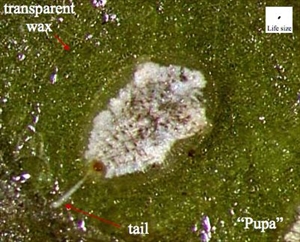- Narrow distribution. On many trees, shrubs and ornamentals. Probably, a minor pest, but little research.
- Adults and nymphs suck the sap causing the leaves to turn and distort; on croton, and other ornamentals, reduces quality.
- Eggs on stalks, laid in rings. Nymphs, at first, active 'crawlers', later, oval, flat, on underside of leaves; pupae, oval, about 0.75 mm long, brownish-yellow, waxy with a white 'tail'. Adults, yellow with red eyes and white, powdery wings.
- Spread by crawlers, or carried by wind, vehicles, animals, birds, on clothes, and the trade in plants.
- Natural enemies: several ladybird beetle predators.
- Cultural control: if pesticides used, remove the most infested leaves before spraying.
- Chemical control: use soap solution, horticulture or white oils (see Fact Sheet no. 56). Note, insecticides will kill natural enemies and probably make the problem worse.





